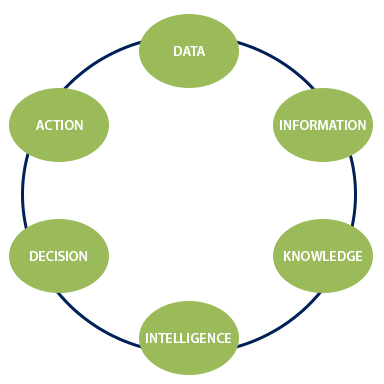How to use the tool to create actionable intelligence.
What To Do With Your Mindmarker Data
Reinforcement is more than sending reminder messages. The following article discusses optimizing your Mindmarker Reinforcement Program by turning the data in your Analytical Tool into Actionable Intelligence.
Based on the reinforcement objectives for learning and behavior outcomes, Mindmarker determines what should be measured. Quiz questions, survey questions, and open-ended questions are used to gather data about participants’ performance and behavior change throughout the Reinforcement Program.
We're often asked to measure everything—"to measure is to know,” they say. A Mindmarker Reinforcement Program isn't an assessment tool. Instead, the participants’ engagement and positive behavior changes are the goals. It’s about optimizing your training by having participants apply what they learned, measuring participants’ behavior change, and proving your training ROI.
Your Mindmarker Analytical Tool will provide you with valuable data. But if you don’t do anything with this data, measuring is useless. Mindmarker emphasizes that clients turn the data in their Analytical Tool into Actionable Intelligence.
Converting Data Into Actionable Intelligence
The process below shows what you should do with the data in your Mindmarker Analytical Tool to make focused actions that drive the improvement of your organization.

- During your Reinforcement Program, data is collected from carefully crafted and planned measurement mindmarkers. The first step is to organize this data.
- After you’ve organized the data it can be converted into information in the form of customized reports from the Analytical Tool.
- The next step is to review and analyze the information to convert it into knowledge.
- Use this knowledge to predict why or what will happen. Knowledge then becomes intelligence.
- Based on this intelligence you can identify potential decisions to be made.
- Make the decision and take action.
However, it doesn’t end here. The cycle continues as you then measure the result of these actions. Organize the data, convert it into information, and so on. This is how raw data turns into Actionable Intelligence. Measuring is so much more than just knowing—you must translate that knowledge into intelligence that drives your actions.
Three Key Points
- For intelligence to have value it must deliver timely answers and actions in order to influence business outcomes.
- The availability of data isn't an immediate way to improve your business. You must translate that data into Actionable Intelligence.
- Statistical models that are missing large sets of data and don’t include influencing data never predict the future; they can be used only to identify past performance.
Questions About Actionable Intelligence
People using Mindmarker's Analytical Tool often ask, “How do I know if I need to take action?” The answer is simple, “How critical are the questions that keep you awake at night?”
The next question is usually, “how many people should be using the Analytical Tool?” Again, the answer is simple, “how many key managers are currently obtaining and using adequate intelligence effectively for decision making?”
Roadblocks You Might Encounter When Using Actionable Intelligence
- Managers don’t value intelligence (“I know my team”)
- Managers consider intelligence a luxury
- Inability to incorporate it into strategy
- The data isn't analyzed by the right people
- The function doesn’t meet the real needs and concerns of decision-makers
- The Actionable Intelligence never makes it to the key decision-makers
The Intelligent Organization and the Mindmarker Solution
There are four important points of attention if you're seriously considering creating an intelligent organization:
- Adjust the decision-making process and culture
- Open communication lines
- Align intelligence to decision-making
- Support the process with technology
